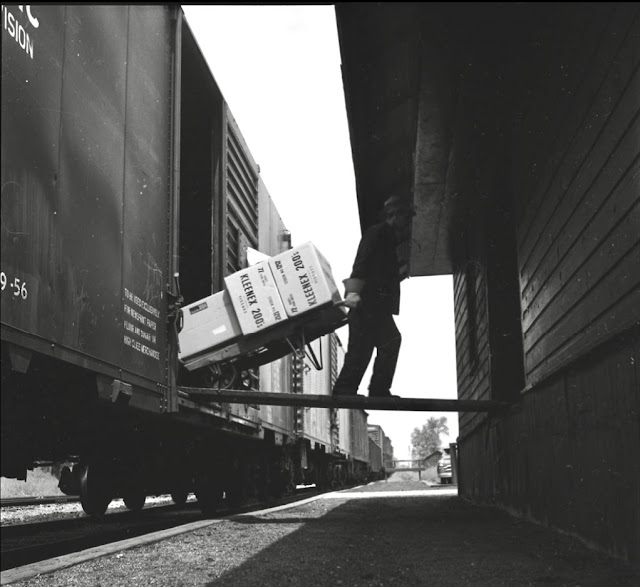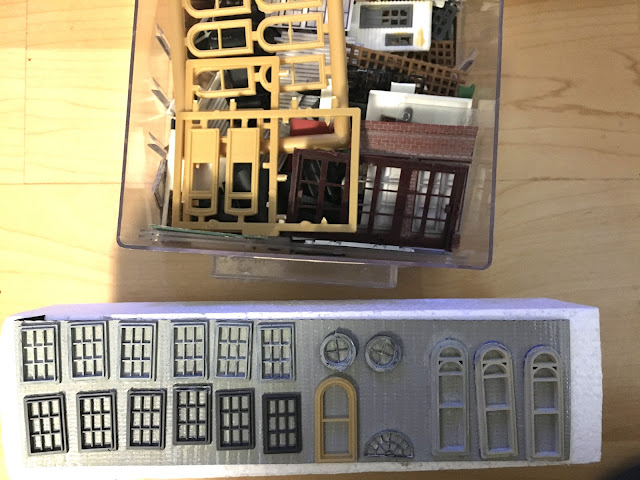When I visited the Queen's University Archives in April, 2019 my first exposure to their collection was viewing some of the digitized images of the George E.O. Lilley fonds. These included a very interesting series of photos taken aboard a CP mixed-train operating out of Kingston. Frustratingly, though I took some grainy 'redneck-screenshots' (pointing my digital camera at the computer terminal screen, with the accompanying annoying lines on the image), by the time I reached the negative envelope of those digitized images in August while making my way through the 51 packed boxes of the Lilley fonds, the negatives in box 38 were not present. I suspected they'd been withdrawn for digitizing.

Eureka! According to the Queen's University Archives
website, as part of the Archives' digitization project, 36 photos taken by George E.O. Lilley dated June 15, 1957 are titled "Last Run of [CP] Trains 612 and 613 from Kingston to Sharbot Lake", (V25.5-38-29-1 to 29-34). These photos centre on a steam-powered mixed-train run making its way north from Kingston, through Harrowsmith, Verona and Sharbot Lake. Added to the 1,100+ digital images available to website visitors, these were added on February 28, 2023 by Digital & Private Records Archivist Jeremy Heil. Since the website is not always the easiest to navigate, and because I believe these photos constitute an amazing record of a sample mixed-train run, albeit latter-day, I've included them in this post.

The photos appeared as part of a Saturday, June 15, 1957 Kingston Whig-Standard news story written by staff reporter E.C. Beer. It seems photographer Lilley rode and documented the train north from Kingston to Sharbot Lake behind CPR D4g 485 on Tuesday, June 11. He then photographed a subsequent southbound run behind CPR 417 as it arrived in Kingston. Whig reporter Cliff Knapp rode and photographed the Saturday, June 15 "last daytime run" which was in turn published in the Monday, June 17 edition of the Whig. The night train would continue hauling passengers and freight but no mail as of Monday, June 17 departing Kingston at 8:30 p.m.
I've added some captions, since the negatives do not include captions, and some details from the Whig article. The train heads under the Highway 401 overpass under construction (near the current Highway 38 - top photo) as Conductor George Giff of Smiths Falls, an 11-year veteran of the run, sits at his 'desk' in the mail/express car reviewing paperwork with his grip on the opposite seat (above). The rattan-covered seats in the gas-lit coach:
The reporter noted that no 'bona fide passengers' were aboard, likely accounting for the discontinuance of the run that was now largely paralleled by a more modern, more convenient highway. Only a couple of 'sentimental observers' who came along to take notes and pictures were aboard, plus the six-man crew shown in the photos, listed below with their years of CP service. A Whig clipping published June 17 shows the crew posing with CP 485, left to right:
- Mail car clerk Joe Lawless
- Baggageman Gerald Harris
- Trainman Ernest DeGracey
- Engineer Glen White (13 years)
- Conductor George Giff (17 years)
- Fireman Clifford Orr (11 years)
At Harrowsmith, there's a pause to re-line the switch after the CP train has gained the joint track section with the CN Smiths Falls Subdivision (receding to left beyond semaphores). The switches were normally
kept lined for CN movements though CN was the 'junior partner' at this junction, albeit operating more trains than CP. The foundation of the former interlocking tower appears to be at right:
Conductor Giff steps down on the platform at Harrowsmith:
Harrowsmith and Sydenham mail courier Mrs. Arthur Harker exchanges mail bags with mail car clerk Joe Lawless:
Holding down the typical baggageman position in mail/express car CP 3450's wooden chair with California oranges, meat and auto parts for Verona, mattresses for Elginburg, a Deluxe Lawn Cruiser power lawnmower for Flinton, shoes and live chicks for Kaladar:
Lunch time in the mail/express car. This is likely baggageman Gerald Harris:

Elginburg-bound mattresses manhandled off the mail/express car. Could this be Hartington? Note the grass-choked siding and no platform:
Mail and express handled at the mail hook-equipped door:
Express shipments and cream can at Verona:
The local merchandise car, interestingly stencilled for CP's International of Maine Division to Saint John, NB handles consignments for Verona, Tichborne and Sharbot Lake. Transfer by hand-cart directly into the freight shed section of Verona station:
Typical views along the line, from bucolic farmland scenes to a hillside and rock-cut, taken from the front and rear vestibules of the coach. Could this be the rock-cut north of Murvale Creek that the train-crew (and my father-in-law) described as difficult at various times of the year due to falling caterpillars and falling leaves making the rails slippery?
The train's consist on this run comprised three empty cars, two gondola cars of scrap metal for Beauharnois, QC, a car of mining equipment for a uranium mine in Spragge, ON (near Sault Ste. Marie) all for Tichborne, and another empty for Peterborough via Sharbot Lake. Add the local merchandise car, mail express car and coach, and we have an exhaust-worthy job for little 485.
I can't be sure, but the above photo is either taken in Kingston as the freight cars are added to the mixed-train consist, or perhaps they're being cut off in Tichborne. Finally, CP 485 with passenger cars, plus 417 backing two boxcars and two passenger cars into the Ontario Street ex-K&P station across from City Hall:
Comparing the photos that George Lilley took with what was published in the Whig, well, there is no comparison. Only one of the above photos, cropped, was included in the article featuring the June 11 ride, published on June 15 (click on image for larger, readable version)...
...another June 15 ride was published on June 17:


 Windows, soldier-corners and front height adjustment added. Rear addition built and roof added, ready to accept front part's roof (below). Dremel made quick work of the window and door openings (front door was one of the last things added!), with paper lintels and Vallejo plastic putty added after 'limestone'.
Windows, soldier-corners and front height adjustment added. Rear addition built and roof added, ready to accept front part's roof (below). Dremel made quick work of the window and door openings (front door was one of the last things added!), with paper lintels and Vallejo plastic putty added after 'limestone'.


.JPG)


















































